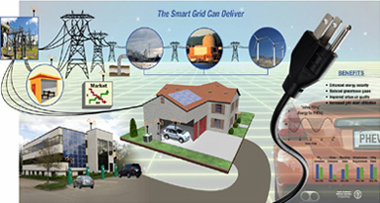|
Smart Grid
The electric grid delivers electricity from points of generation to consumers, and the electricity delivery network functions via two primary systems: the transmission system and the distribution system. The transmission system delivers electricity from power plants to distribution substations, while the distribution system delivers electricity from distribution substations to consumers. The grid also encompasses myriads of local area networks that use distributed energy resources to serve local loads and/or to meet specific application requirements for remote power, village or district power, premium power, and critical loads protection.
“The Smart Grid: An Introduction ” is a publication sponsored by DOE’s Office of Electricity Delivery and Energy Reliability. It is the first book of its kind to explore – in layman’s terms – the nature, challenges, opportunities and necessity of Smart Grid implementation.
DOE is conducting a series of Smart Grid E-Forums to discuss various issues surrounding Smart Grid including costs, benefits, value proposition to consumers, implementation, and deployment.
The Federal Smart Grid Task Force was recently established under Title XIII of the Energy Independence and Security Act of 2007 to coordinate smart grid activities across the Federal government.
Grid 2030 vision (PDF 1.1 MB) calls for the construction of a 21st century electric system that connects everyone to abundant, affordable, clean, efficient, and reliable electric power anytime, anywhere. We can achieve this through a smart grid, which would integrate advanced functions into the nation's electric grid to enhance reliability, efficiency, and security, and would also contribute to the climate change strategic goal of reducing carbon emissions. These advancements will be achieved by modernizing the electric grid with information-age technologies, such as microprocessors, communications, advanced computing, and information technologies.
Electric grid stakeholders representing utilities, technology providers, researchers, policymakers, and consumers have worked together to define the functions of a smart grid. Through regional meetings convened under the Modern Grid Strategy project of the National Energy Technology Laboratory (NETL), these stakeholders have identified the following characteristics or performance features of a smart grid:
- Self-healing from power disturbance events
- Enabling active participation by consumers in demand response
- Operating resiliently against physical and cyber attack
- Providing power quality for 21st century needs
- Accommodating all generation and storage options
- Enabling new products, services, and markets
- Optimizing assets and operating efficiently

Download Diagram (PDF 116 KB)
Smart Grid Activities >
|